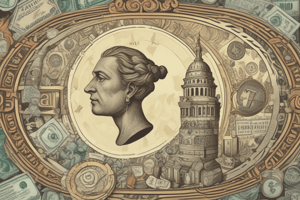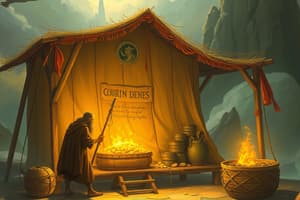Podcast
Questions and Answers
What is the effect of an increase in the interest rate on planned investment?
What is the effect of an increase in the interest rate on planned investment?
- It reduces planned investment. (correct)
- It increases planned investment.
- It has no effect on planned investment.
- It is uncertain and depends on the situation.
What is the relationship between the interest rate and the cost of borrowing to finance investment projects?
What is the relationship between the interest rate and the cost of borrowing to finance investment projects?
- The interest rate is irrelevant to borrowing.
- The interest rate is only a partial cost of borrowing.
- The interest rate is the cost of borrowing. (correct)
- The interest rate is the benefit of borrowing.
What happens to the planned expenditure curve in the Keynesian cross when the interest rate increases?
What happens to the planned expenditure curve in the Keynesian cross when the interest rate increases?
- It remains unchanged.
- It shifts to the left. (correct)
- It shifts to the right.
- It becomes steeper.
What is the result of a decrease in planned investment on income in the Keynesian cross?
What is the result of a decrease in planned investment on income in the Keynesian cross?
What is the shape of the investment function?
What is the shape of the investment function?
What is the effect of an increase in the interest rate on the economy?
What is the effect of an increase in the interest rate on the economy?
What is the role of the interest rate in determining investment?
What is the role of the interest rate in determining investment?
What is the relationship between the interest rate and income in the Keynesian cross?
What is the relationship between the interest rate and income in the Keynesian cross?
What happens to the IS curve when the interest rate increases?
What happens to the IS curve when the interest rate increases?
What is the effect of an increase in the interest rate on the planned expenditure curve?
What is the effect of an increase in the interest rate on the planned expenditure curve?
Study Notes
Commodity Money
- Commodity money takes the form of a commodity with intrinsic value, such as gold.
- Intrinsic value obtains when the commodity itself has value, even if it were not used as money.
- Gold has been used as money throughout history.
Fractional Banking System
- Goldsmiths served as bankers and laid the foundation of modern fractional banking system.
- They issued receipts in excess of the gold holdings, creating the modern paper currency or banknotes.
- The central bank was formed and given the monopoly to issue currency, operating under a gold standard.
Fiat Money/Token
- Fiat money works in two ways: expansionary or contractionary.
- Expansionary monetary policy increases money supply, while contractionary monetary policy reduces money supply.
- Central bank buys government bonds to increase money supply, or sells bonds to reduce money supply.
Expansionary Monetary Policy
- Buying government bonds from banks increases bank deposits, allowing banks to lend more.
- This creates a ripple effect, increasing lending and money supply, and subsequently aggregate demand.
Contractionary Monetary Policy
- Selling government bonds reduces money supply, increasing interest rates and reducing aggregate demand.
- Contractionary monetary policy is implemented when there is high inflation in the economy.
Interest Rate and Monetary Policy: Liquidity Preference Model
- According to Keynes, the total money supply (Ms) is fixed in the short run and is independent of the interest rate.
- Ms is determined by the central monetary authorities and is independent of the interest rate.
- An increase in Ms shifts the Ms curve to the right, while a decrease shifts it to the left.
Money Market Equilibrium
- The LM curve shows the combinations of the interest rate and level of income that are consistent with equilibrium in the market for real money balances.
- The LM curve shifts upward with a decrease in the supply of real money balances and downward with an increase.
- The quantity of money demanded rises with the level of output (Y) but falls with the level of the interest rate (r).
Goods Market Equilibrium
- The IS curve shows the combinations of the interest rate and level of income that are consistent with equilibrium in the goods market.
- An increase in the interest rate reduces planned investment.
- The investment function slopes downward, showing that an increase in the interest rate reduces planned investment.
Studying That Suits You
Use AI to generate personalized quizzes and flashcards to suit your learning preferences.
Description
This quiz explores the concept of commodity money, its intrinsic value, and how goldsmiths issued receipts that eventually led to the creation of modern paper currency.




